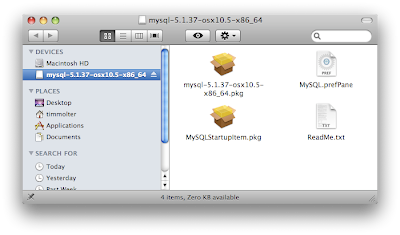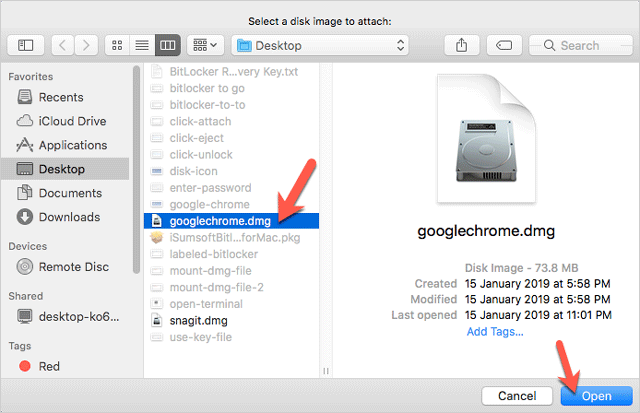Install Dmg File On Mac Terminal
Open DMG File on Mac OS
Since DMG is a native Mac OS disk image format opening DMG file is as easy as double clicking on it in Finder. When you open DMG file this way, disk image stored inside DMG file will be mounted, and then opened in a separate Finder window. If DMG contains installation of an application, then installation window of the app will open. If not, then you will see the disk image content. Even in case when disk image contains installation of the application you can still view contents of the mounted DMG file by clicking on its name in Finder Locations section or by selecting Go->Go to Folder… in Finder menu, typing /Volumes/ and clicking Go button.
Dec 04, 2015 Method to Install.dmg Format Apps on Mac OS X – Pre-Requisites – The.dmg File of the App you want to install. Download & Save the.dmg file in any folder. Non-Guest User account access in Mac OS X (Any User account with app-install permissions or Administrator account). I have a.dmg MacOS package (with 'continue' buttons, EULA etc) that i need to install on multiple computers. Is it a way to do so silently via a bash/python/ruby/etc script just like silent MSI. Since DMG is a native Mac OS disk image format opening DMG file is as easy as double clicking on it in Finder. When you open DMG file this way, disk image stored inside DMG file will be mounted, and then opened in a separate Finder window.
Mount and unmount using Hdiutil
Since DMG is a native Mac OS disk image format opening DMG file is as easy as double clicking on it in Finder. When you open DMG file this way, disk image stored inside DMG file will be mounted, and then opened in a separate Finder window. If DMG contains installation of an application, then installation window of the app will open. Dec 10, 2008 It can be used as a remote desktop client for Linux, Mac, or Windows hosts. The download file is named 'cotvnc-20b4.dmg'. Here are the steps needed to install it remotely from the command line. Note: this technique can be used from a local Terminal window or a remote SSH connection. Mount the disk image.
To mount a disk image using hdiutil you need to open terminal app and type following command there:
hdiutil mount example.dmg
To unmount type:
hdiutil unmount /Volumes/example
Where /Volumes/example is a path where disk image was mounted
Mount using DiskImageMounter.app
You can quickly mount DMG file by Control-Clicking on it and selecting Open With->DiskImageMounter.app. This will mount DMG file and its content will become available in Finder Locations and /Volumes folder.
Mount using Disk Utility
You can also mount DMG file using Disk Utility application available in Mac OS. Eso necromancer 1m dmg in battleground 3. Look for Disk Utility using Launcher and launch it. After that select File->Open Disk Image… in the main menu and choose DMG file you want to mount. After clicking Open you should see a screen like below where disk image details will be shown including used and free space, mount point, disk type and more.
You can also access disk image mounted by Disk Utility in Finder Locations or /Volumes folder.
Once application located in the DMG file is installed it is safe to delete it since DMG file is only needed during the installation process.
This topic includes the following sections:
System Requirements for Installing the JDK on macOS
The following are the system requirements for installing the JDK on macOS:
Any Intel-based computer running macOS.
Administrator privileges.
You cannot install Java for a single user. Installing the JDK on macOS is performed on a systemwide basis for all users. Administrator privileges are required to install the JDK on macOS.
Determining the Default JDK Version on macOS
When starting a Java application through the command line, the system uses the default JDK.
You can determine which version of the JDK is the default by entering java -version in a Terminal window. If the installed version is 13 Interim 0, Update 0, and Patch 0, then you see a string that includes the text 13. For example:
To run a different version of Java, either specify the full path, or use the java_home tool. For example:
$ /usr/libexec/java_home -v 13 --exec javac -version
Installing the JDK on macOS
- Download the JDK
.dmgfile,jdk-13.interim.update.patch_osx-x64_bin.dmg.Before the file can be downloaded, you must accept the license agreement.
- From either the browser Downloads window or from the file browser, double-click the
.dmgfile to start it.A Finder window appears that contains an icon of an open box and the name of the.pkgfile. - Double-click the
JDK 13.pkgicon to start the installation application.The installation application displays the Introduction window. - Click Continue.
- Click Install. A window appears that displays the message: Installer is trying to install new software. Enter your password to allow this.
- Enter the Administrator user name and password and click Install Software.The software is installed and a confirmation window is displayed.
.dmg file if you want to save disk space. Uninstalling the JDK on macOS
You must have Administrator privileges.
Note:
Do not attempt to uninstall Java by removing the Java tools from /usr/bin. This directory is part of the system software and any changes will be reset by Apple the next time that you perform an update of the OS.
- Go to
/Library/Java/JavaVirtualMachines. - Remove the directory whose name matches the following format by executing the
rmcommand as a root user or by using thesudotool:/Library/Java/JavaVirtualMachines/jdk-13.interim.update.patch.jdkFor example, to uninstall 13 Interim 0 Update 0 Patch 0:
$ rm -rf jdk-13.jdk
Installation FAQ on macOS Platform
This topic provides answers for the following frequently asked questions about installing JDK on macOS computers.
1. How do I find out which version of Java is the system default?
When you run a Java application from the command line, it uses the default JDK. If you do not develop Java applications, then you do not need to worry about this. See Determining the Default JDK Version on macOS.
2. How do I uninstall Java?
Install Dmg File On Mac Terminal 1
See Uninstalling the JDK on macOS.
3. After installing Java for macOS 2012-006, can I continue to use Apple's Java 6 alongside the macOS JDK for Java 13?
If you want to continue to develop with Java 6 using command-line, then you can modify the startup script for your favorite command environment. For bash, use this:
$ export JAVA_HOME=`/usr/libexec/java_home -v 13`
Some applications use /usr/bin/java to call Java. After installing Java for macOS 2012-006, /usr/bin/java will find the newest JDK installed, and will use that for all of the Java-related command-line tools in /usr/bin. You may need to modify those applications to find Java 6, or contact the developer for a newer version of the application.
4. What happened to the Java Preferences app in Application Utilities?
How To Install Dmg File

Install Dmg File On Mac Terminal 5
The Java Preferences app was part of the Apple Java installation and is not used by Oracle Java. Therefore, macOS releases from Apple that do not include Apple Java will not include Java Preferences.